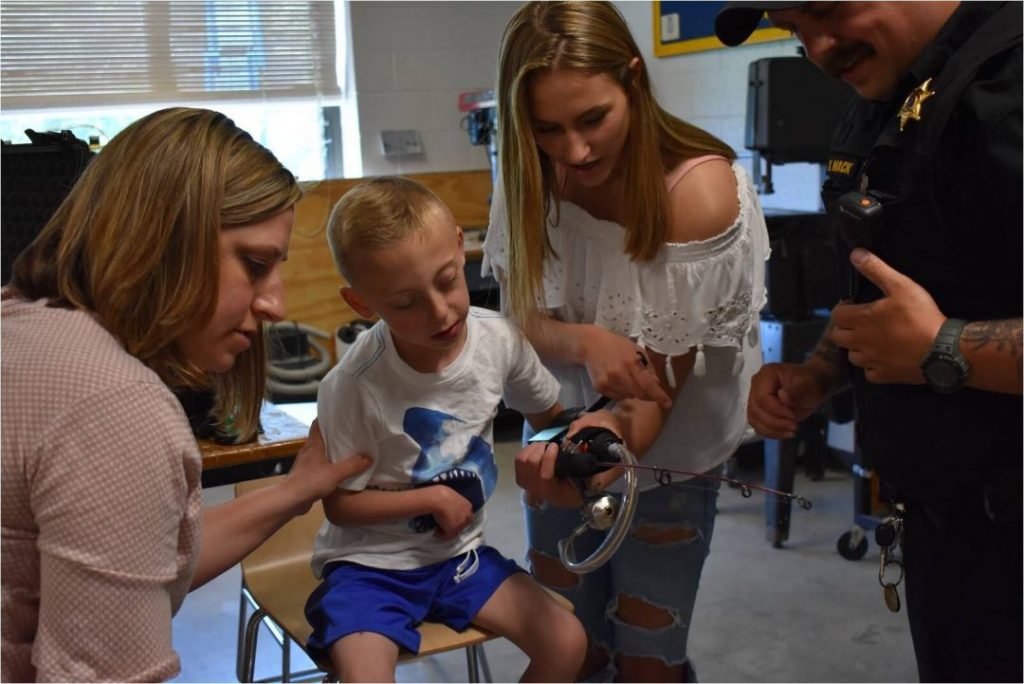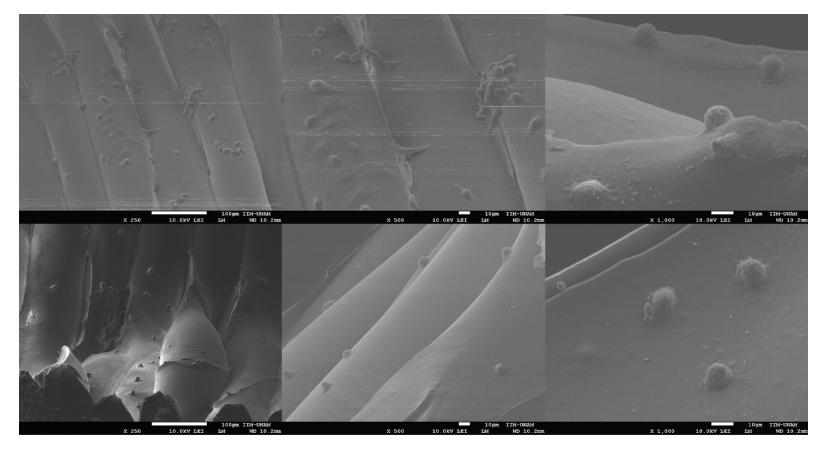In the paper “Three‐Dimensional Bioprinting in Regenerative Medicine: Reality, Hype, and Future,” authors Anthony Atala and Gabor Forgacs explore some necessary topics within 3D printing and bioprinting. The technology has brought forth incredible innovation capable of transforming manufacturing, design mechanisms, and offering never dreamed of self-sustainability that could be even more useful in the future for the military, aerospace, and many other organizations.

Organizations like NASA have been using 3D printing for decades. This image shows an example of 3D printed engine nozzles they have been perfecting recently. {Image: NASA, from ‘NASA Develops New 3D Printing Method for Fabricating Rocket Engine Nozzles‘)
Healthcare, however, and the medical realm have already been heavily impacted by 3D printing. The momentum continues to accelerate undeniably too, as researchers discover new ways to improve the lives (and perhaps even save them) of patients in dire need of relief or assistance through numerous different types of devices and implants.
Beyond all the hullabaloo and the hype though, with talk of technological magic and industrial revolution, the authors examine the real potential for bioprinting and further progress in regenerative medicine. To begin, they remind us of the staggering complexity of the human body, evolved during millions of years of trial and error and the weeding out of imperfections with natural selection:
“As a consequence, present day tissues and organs are all complex, and their complexity varies depending on the cell type and organization, architecture and function. Flat tissues (e.g., skin) are the least complex, tubular structures (e.g., blood vessels) more complex, hollow nontubular organs (e.g., bladder) even more complex, and solid organs (e.g., liver or heart) the most complex,” state Atala and Forgacs.
They also comment on recent stem cell technology advancements, the ability to grow cells in vitro, and the impact of engineering from within the lab—resulting in some organs that have been implanted in patients during clinical trials.
“Several tissue‐engineered products are advancing through the regulatory pathway so they can be eventually commercialized and disseminated widely. However, most of the engineered tissues now in the more advanced stages of the regulatory pathway were made by hand,” state the authors.
Although at this point you may have become desensitized to ongoing news about the engineering of tissue in the lab, it is certainly no easy feat. A tissue biopsy must be taken, cells must be coddled into growth and beyond that must survive, which is the greatest challenge, aside from implanting them for the required application at hand.
“Harvesting and cell expansion techniques, culture media protocols, growth factor additives, environmental conditions, and sterility, are just a few of the many details necessary to have the right cells as a starting material. Furthermore, an adult liver for example contains approximately 100 billion cells, and is composed of multiple cell types, including hepatocytes, stellate cells, and Kupffer cells. In order to create such an organ, the various cells need to be expanded at the same time, to large numbers and thus divided many times outside of the body. Extreme care needs to be exercised to make sure that the resulting cells do not become transformed and remain functional consistent with their intended use,” remind the authors.
Materials are complex in tissue engineering and bioprinting, obviously. Many different elements must be in place, and conditions must near perfection, along with all interactions between cells and chemicals—and accompanying technology. 3D printing, although available for decades now and used by engineers as well as aerospace and automotive companies, has become so accessible and affordable that it is becoming commonplace in schools, libraries, labs, hospitals, and many businesses and factories.

STEM technology has really taken off in the US educational system. Students from Stockbridge High School in Michigan were the recipients of XYZPrinting 3D printing technology. Here, they are pictured with a young boy they created a fishing rod adapter for. (Photo credit: XYZPrinting, from ‘XYZprinting: Investing $1 Million in US STEAM 3D Education Program.’)
As the technology has also branched off into bioprinting and automation, via cell-laden, extruded inks, researchers have discovered the following benefits:
- Affordability
- Reproducibility
- Scalability
- Precision
- Automation
As the authors point out, progress has indeed been remarkable; however, hitting the mark with fabrication of human organs has not been as easy a goal to meet as previously expected:
“Just like toys could be printed with the push of a button, many thought, tissues and organs would be printed in a similar manner. However, nothing could have been further from the truth.”
Bioprinting is an extremely complex undertaking with the most delicate materials imaginable: human cells. And while such technology may have sprung from the dynamics of 3D printing, the process and outcome are much different, comparing the simplicity of a completed, functional object with cells that must be nurtured into the desired form—with the ultimate target being that of an actual human organ.

International researchers continue to make strides in bioprinting. Here, they have created tubular structures seeded with cells. (Image: Biocompatibility of Developing 3D Printed Tubular Scaffold Coated with Nanofibers for Bone Applications‘)
“In the more distant future, with further progress in large‐scale cell culture, bioprocess engineering, and genetic strategies, it is possible that we will be able to design specific printable living structures that are not even conceivable today,” say the authors.
“Tissues printed with gene‐edited cells from the diseased patient to achieve a normal endpoint or combination of extended bioprinted tissue units functionally interconnected similarly to that in the human body are examples that could lead to unforeseen progress in regenerative medicine. Bioprinting offers many promising opportunities. However, patience and perseverance are needed to realize the full potential of the technology.”

(Image from Bioprinting 101)
If you want to learn about true perseverance—combined with affinity for technology and innovation—just keep your eye on progress emerging from 3D printing users of all kinds from all over the world. Due to the intrinsic and infinite opportunity to create offered by 3D printing technology, engineers, designers, tinkerers, makers, manufacturers, and many more are drawn to trying their hand at finding ways to improve on conventional parts and prototypes, along with constantly perfecting and stretching the limits of their tools.
The results of bioprinting, demonstrating strides in patient care from corneal grafts to 3D printed brain tumors, often leave us incredulous over learning what is happening in research labs globally; however, the true reward for most who are involved in such studies will be successfully 3D and 4D printing human organs that can be used as transplants and truly change the face of modern medicine forever.
What do you think of this news? Let us know your thoughts! Join the discussion of this and other 3D printing topics at 3DPrintBoard.com.
[Source: Three‐Dimensional Bioprinting in Regenerative Medicine: Reality, Hype, and Future]Subscribe to Our Email Newsletter
Stay up-to-date on all the latest news from the 3D printing industry and receive information and offers from third party vendors.
You May Also Like
3D Printing Unpeeled: New Arkema Material for HP, Saddle and Macro MEMS
A new Arkema material for MJF is said to reduce costs per part by up to 25% and have an 85% reusability ratio. HP 3D HR PA 12 S has been...
3D Printing News Briefs, January 20, 2024: FDM, LPBF, Underwater 3D Printer, Racing, & More
We’re starting off with a process certification in today’s 3D Printing News Briefs, and then moving on to research about solute trapping, laser powder bed fusion, and then moving on...
3D Printing Webinar and Event Roundup: December 3, 2023
We’ve got plenty of events and webinars coming up for you this week! Quickparts is having a Manufacturing Roadshow, America Makes is holding a Member Town Hall, Stratafest makes two...
Formnext 2023 Day Three: Slam Dunk
I’m high—high on trade show. I’ve met numerous new faces and reconnected with old friends, creating an absolutely wonderful atmosphere. The excitement is palpable over several emerging developments. The high...































